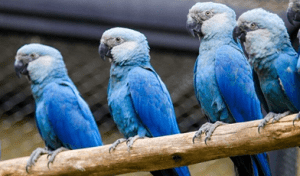TAG: GS 3: ECOLOGY AND ENVIRONMENT
THE CONTEXT: The Spix’s macaw (Cyanopsitta spixii), one of the world’s most threatened parrots, faced extinction in the wild at the turn of the millennium.
EXPLANATION:
- The primary causes of its disappearance were the illegal pet trade and extensive habitat degradation in its native Brazil.
- However, a groundbreaking reintroduction program launched in 2022 has shown promising signs of recovery for this iconic species.
- The Spix’s macaw was declared extinct in the wild in 2000. This decline was driven by rampant poaching for the illegal pet trade, where the birds fetched high prices due to their rarity and striking appearance.
- Additionally, their natural habitat, the riparian woodlands of Brazil, was severely degraded by agricultural expansion and deforestation.
- Recognizing the dire need for action, conservationists embarked on an ambitious reintroduction program.
- Captive breeding efforts were intensified, with a significant portion of the global population of Spix’s macaws being housed in a specialized breeding center in Germany.
The 2022 Reintroduction Success
- In 2022, the first group of 20 Spix’s macaws, bred in captivity, was released back into the wild.
- The program was meticulously planned and executed, involving extensive preparation to ensure the birds’ survival in their natural habitat.
- Measures included habitat restoration, community engagement, and close monitoring of the released birds.
- The reintroduction achieved remarkable success, with the first wild hatchings of Spix’s macaw chicks in decades.
- This event was celebrated as a major victory for conservation, demonstrating the potential for captive breeding programs to restore extinct-in-the-wild species.
Challenges
- Despite the initial success, the future of the Spix’s macaw reintroduction project is now shrouded in uncertainty.
- In June 2024, the cooperation agreement between the Brazilian government and the German breeding center, which houses most of the world’s Spix’s macaws, ended without renewal.
- This development has cast doubt on the continuity and sustainability of the project.
Implications of the Agreement’s End
- The termination of the agreement poses several risks:
- Funding and Resource Constraints: The breeding center in Germany played a crucial role in financing and supporting the reintroduction efforts. Without renewed cooperation, there may be significant gaps in funding and resources needed to sustain ongoing conservation activities in Brazil.
- Coordination and Expertise: The partnership facilitated the exchange of expertise and coordinated efforts between international and local conservationists. The end of the agreement could disrupt this collaboration, affecting the quality and effectiveness of conservation strategies.
- Long-term Monitoring and Support: Continuous monitoring and support are essential to ensure the survival and adaptation of reintroduced macaws. The absence of a formal agreement could hinder these efforts, jeopardizing the progress made so far.
Recommendations and Conservation
- To address these challenges and secure the future of the Spix’s macaw, several steps are crucial:
- Renewal of Agreements: It is imperative for the Brazilian government and international partners to renegotiate and renew cooperation agreements. Such collaborations are vital for pooling resources, expertise, and efforts toward the common goal of conserving the Spix’s macaw.
- Sustainable Funding Mechanisms: Establishing sustainable funding mechanisms, such as endowments or international grants, can provide a stable financial base for long-term conservation activities.
- Community Engagement: Continued engagement with local communities is essential to ensure their support and involvement in conservation efforts. Empowering communities through education and sustainable livelihood opportunities can foster a sense of ownership and responsibility toward protecting the Spix’s macaw.
- Scientific Research and Monitoring: Ongoing scientific research and monitoring are critical to understanding the challenges faced by reintroduced populations and adapting conservation strategies accordingly.
Spix’s macaw
- Spix’s macaw (Cyanopsitta spixii), also known as the little blue macaw, is a macaw species that was endemic to Brazil.
- It is a member of tribe Arini in the subfamily Arinae (Neotropical parrots), part of the family Psittacidae (the true parrots).
- It was first described by German naturalist Georg Marcgrave, when he was working in the State of Pernambuco, Brazil in 1638 and it is named for German naturalist Johann Baptist von Spix, who collected a specimen in 1819 on the bank of the Rio São Francisco in northeast Bahia in Brazil.
- This bird has been completely extirpated from its natural range, and following a several-year survey, the IUCN officially declared it extinct in the wild in 2019.
- However, after over 20 years of conservation efforts, 200 macaws have been bred from just two parent birds, and 52 individual birds have since been reintroduced into their natural environment in June 2022.


